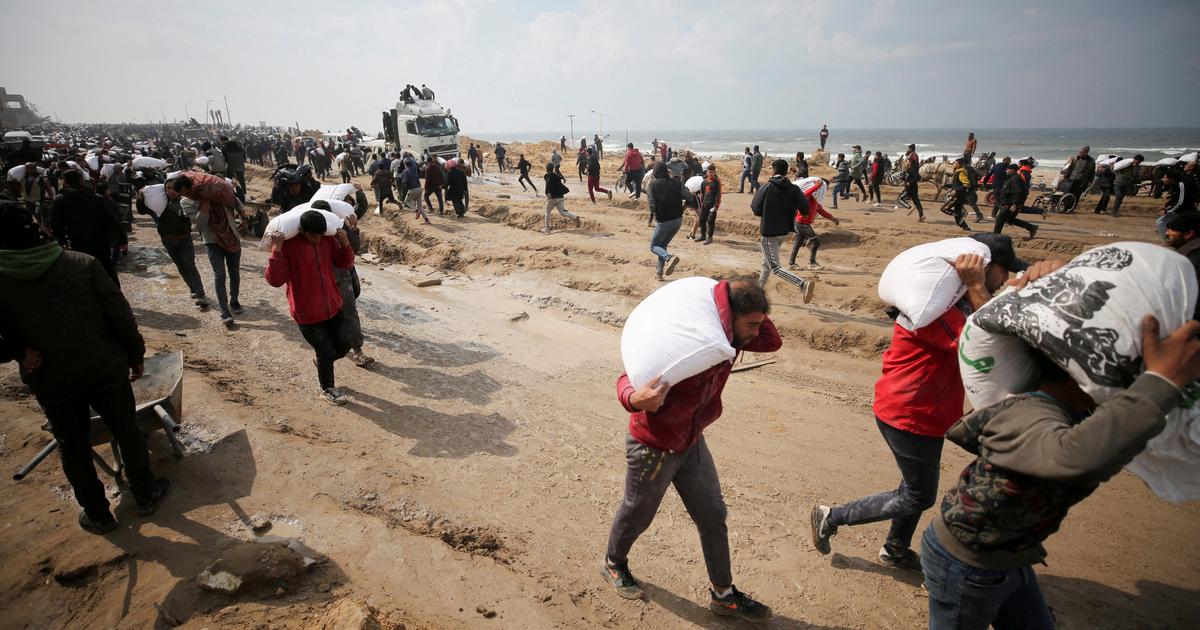On the night of February 28 to 29 in Gaza, a crowd movement during the ransacking of humanitarian aid trucks and the response of the Israeli army with gunfire led to a bloodbath.
Around 100 people died and around 700 were injured.
Dr Isabelle Defourny, president of Médecins sans frontières (MSF) France, returns to
Le Figaro
on this new tragedy in Gaza.
LE FIGARO. - What do you know about what happened last night during the food distribution in Gaza?
ISABELLE DEFOURNY. -
MSF does not have first-hand information on what happened.
However, during our distribution operations, our teams have witnessed this type of scene several times.
In reality the distributions are not really: the population is worried and helps themselves directly from the trucks.
The Israeli army speaks of “looting”. Is this the act of one of the Palestinian gangs which, in the territory, make attacks on humanitarian convoys their specialty?
I looked at the images of the scene yesterday, and from what our teams themselves observed in Rafah (south of the Gaza Strip, on the border with Egypt), it is clearly of a starving population storming trucks.
Too little aid is entering Gaza.
There are many checks before entering, and once inside, there are no real distributions.
People help themselves from the trucks.
Some trucks were emptied as early as Rafah, without arriving in the North.
The Palestinians are hungry, they are extremely worried, and there are very high concentrations of populations.
In Rafah, there is six times more population than at the start of this war.
For our part, we have not observed any looting by armed factions.
Do you consider that there is a responsibility of the Israeli army in yesterday's tragedy?
I would say yes.
Whatever the exact circumstances, the responsibility for this chaos lies with those who organized and still organize the food shortage.
What happened is a tragedy, but it is not surprising in the face of a hungry and worried population.
MSF has been warning for weeks and months that there are no minimum conditions in Gaza to allow the deployment of aid.
Setting up humanitarian aid operations under bombardment is mission impossible!
There absolutely must be a cessation of hostilities.
Should aid trucks be more protected?
This is a request that we already made a long time ago.
But I don't think putting more soldiers around convoys is a sufficient solution.
Situations are anyway dangerous when people are hungry.
For the distributions to go well, the population must above all be reassured, that they know when the trucks will arrive, with the assurance that others will come and that there will be enough for everyone. .
The territory is in the grip of real civil disorder.
The bombings are incessant, the humanitarian staff themselves are unable to act, there are no more police.
It is this chaos that makes us say that there are not the minimum conditions for humanitarian aid to be distributed.
There needs to be a ceasefire.
The amount of aid through Gaza must be announced and increased.
We must reassure the population.
Are sky drops less exposed to these scenes of chaos?
The aid that has so far been airlifted by the French and the Jordanians represents minimal quantities.
And then, any help is welcome, but food that falls from the sky without any distribution, that people have to go get themselves, is the last alternative!
This process was only used very rarely, in very remote regions like South Sudan years ago.
Can we speak of general famine in Gaza?
Today, we are still talking about the risk of famine.
This is not a hypothetical risk, rather a very serious threat.
The numbers say it.
According to the UN, 2.2 million people are currently at risk of famine.
90% of the population does not have enough to eat.
In the north of the territory, one in six children is acutely malnourished.
And this record will continue to deteriorate if the war continues.
We also see it directly in our staff.
Nearly 300 Palestinians work for us in Gaza and tell us they are hungry.
The rate of malnutrition is equivalent to certain regions such as the Sahel; this lack had never existed in Gaza.

